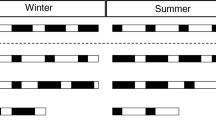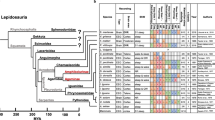Abstract
Although most mammals experience rapid eye movement (REM) sleep, the primary function of REM sleep is still debatable. Current data show that aquatic mammals have absent or reduced REM sleep and that semi-aquatic mammals have reduced REM sleep when in water. A few theories have been proposed to explain this reduction in REM sleep in aquatic mammals. Some investigators proposed that seals’ switch from bilateral to uni-hemispheric non-REM sleep in water may render REM sleep unnecessary, and suggested that REM may serve to reverse the brain cooling that occurs in bilateral non-REM sleep. Another proposed theory is the effect of gravity on REM sleep and that aquatic and semi-aquatic species do not need REM sleep in low weightless environments due to the effect of gravity on sleep. In this viewpoint, we critically review a few proposed theories and their supporting evidence.
Similar content being viewed by others
References
Zepelin H, Siegel JH, Tobler I. Mammalian Sleep. In: Kryger MH, Roth T, Dement WC, editors. Principles and practice of sleep medicine. Philadelphia: Elsevier; 2005. p. 91–100.
Aserinsky E, Kleitman N. Regularly occurring periods of eye motility, and concomitant phenomena, during sleep. Science. 1953;118:273–4.
Madan V, Jha SK. Sleep alterations in mammals: did aquatic conditions inhibit rapid eye movement sleep? Neurosci Bull. 2012;28(6):746–58.
Lyamin OI, Lapierre JL, Mukhametov LM. Sleep in aquatic species. In: Kushida CA, editor. The encyclopedia of sleep. Philadelphia: Elsevier Inc.; 2013. p. 57–62.
Aleman M, Williams DC, Holliday T. Sleep and sleep disorders in horses. AAEP Proc. 2008;54:180–5.
Lyamin OI, Manger PR, Ridgway SH, Mukhametov LM, Siegel JM. Cetacean sleep: an unusual form of mammalian sleep. Neurosci Biobehav Rev. 2008;32(8):1451–84.
Mascetti GG. Unihemispheric sleep and asymmetrical sleep: behavioral, neurophysiological, and functional perspectives. Nat Sci Sleep. 2016;8:221–38.
Lyamin OI, Kosenko PO, Lapierre JL, Mukhametov LM, Siegel JM. Fur seals display a strong drive for bilateral slow-wave sleep while on land. J Neurosci. 2008;28(48):12614–21.
Mukhametov LM, Lyamin OI, Polyakova IG. Interhemispheric asynchrony of the sleep EEG in northern fur seals. Experientia. 1985;41(8):1034–5.
Lyamin OI, Oleksenko AI, Mukhametov LM. Paradoxical sleep in northern fur seals in water and on land. J Sleep Res. 1996;3(suppl 1):259.
Lyamin OI, Kosenko PO, Korneva SM, Vyssotski AL, Mukhametov LM, Siegel JM. Fur seals suppress REM sleep for very long periods without subsequent rebound, current biology. Curr Biol. 2018;10:10. https://doi.org/10.1016/j.cub.2018.05.022.
Pryaslova JP, Lyamin OI, Siegel JM, Mukhametov LM. Behavioral sleep in the walrus. Behav Brain Res. 2009;201(1):80–7.
Castellini MA, Milsom WK, Berger RJ, Costa DP, Jones DR, Castellini JM, et al. Patterns of respiration and heart rate during wakefulness and sleep in elephant seal pups. Am J Physiol. 1994;266(3 Pt 2):R863–9.
Lyamin OI. Sleep in the harp seal (Pagophilus groenlandica). Comparison of sleep on land and in water. J Sleep Res. 1993;2(3):170–4.
Kräuchi K, Deboer T. Body temperatures, sleep, and hibernation. In: Kryger MH, Roth T, Dement WC, editors. Principles and practice of sleep medicine. Philadelphia, PA: Elsevier Health Sciences; 2011.
Heller H. Temperature, thermoregulation and sleep. In: Kryger MH, Roth T, Dement WC, editors. Principles and practice of sleep medicine. Philadelphia: Elsevier-Saunders; 2005. p. 292–304.
Rosenthal MS, Vogel GW. The effect of a 3-day increase of ambient temperature toward the thermoneutral zone on rapid eye movement sleep in the rat. Sleep. 1993;16(8):702–5.
Gonfalone AA, Jha SK. The influence of gravity on REM sleep. Open Access Anim Physiol. 2015;7:65–72.
Stickgold R, Hobson JA. REM sleep and sleep efficiency are reduced during space flight. Life Sci Space Res. 2015;4:62–6.
Flynn-Evans E, Gregory K, Arsintescu L, Whitmire A. Human research program behavioral health and performance element. Evidence report: risk of performance decrements and adverse health outcomes resulting from sleep loss, circadian desynchronization, and work overload 2015;1–76.
Gonfalone A. Sleep on manned space flights: zero gravity reduces sleep duration. Pathophysiology. 2016;23(4):259–63.
Miller PJ, Aoki K, Rendell LE, Amano M. Stereotypical resting behavior of the sperm whale. Curr Biol. 2008;18(1):R21–3.
Robin ED, Whaley RD, Crump CH, Travis DM. Alveolar gas tensions, pulmonary ventilation and blood pH during physiologic sleep in normal subjects. J Clin Invest. 1958;37(7):981–9.
McKay LC, Atalla A, Morrell MJ. Physiology and neural control of breathing during sleep. In: McNicholas WT, Bonsignore MR, editors. Sleep apnea. Sheffield: European Respiratory Society; 2011. p. 1–16.
Dean JB, Kinkade EA, Putnam RW. Cell-cell coupling in CO(2)/H(+)-excited neurons in brainstem slices. Respir Physiol. 2001;129(1–2):83–100.
Madan V, Jha SK. A moderate increase of physiological CO(2) in a critical range during stable NREM sleep episode: a potential gateway to REM sleep. Front Neurol. 2012;3:19.
Li A, Nattie E. Catecholamine neurones in rats modulate sleep, breathing, central chemoreception and breathing variability. J Physiol. 2006;570(Pt 2):385–96.
Noren SR, Williams TM, Ramirez K, Boehm J, Glenn M, Cornell L. Changes in partial pressures of respiratory gases during submerged voluntary breath hold across odontocetes: is body mass important? J Comp Physiol B. 2012;182(2):299–309.
Huntley AC, Costa DP, Rubin RD. The contribution of nasal countercurrent heat exchange to water balance in the northern elephant seal, Mirounga angustirostris. J Exp Biol. 1984;113:447–54.
Rattenborg NC, Voirin B, Cruz SM, Tisdale R, Dell’Omo G, Lipp HP, et al. Evidence that birds sleep in mid-flight. Nat Commun. 2016;7:12468.
Cai ZJ. A new function of rapid eye movement sleep: improvement of muscular efficiency. Physiol Behav. 2015;144:110–5.
Ayala-Guerrero F, Mexicano G, Ramos JI. Sleep characteristics in the turkey Meleagris gallopavo. Physiol Behav. 2003;78:435–40.
BaHammam A. Effect of fasting during Ramadan on sleep architecture, daytime sleepiness and sleep pattern. Sleep Biol Rhythm. 2004;2:135–43.
Bahammam AS, Almushailhi K, Pandi-Perumal SR, Sharif MM. Intermittent fasting during Ramadan: does it affect sleep? J Sleep Res. 2014;23(1):35–43.
Kotrbacek V, Schweigel M, Honig Z. The effect of short-term fasting on sleep in pigs. Vet Med (Praha). 1990;35(9):547–52.
Roky R, Chapotot F, Hakkou F, Benchekroun MT, Buguet A. Sleep during Ramadan intermittent fasting. J Sleep Res. 2001;10(4):319–27.
Bahammam AS, Nashwan S, Hammad O, Sharif MM, Pandi-Perumal SR. Objective assessment of drowsiness and reaction time during intermittent Ramadan fasting in young men: a case-crossover study. Behav Brain Funct. 2013;9(1):32.
Goder R, Seeck-Hirschner M, Stingele K, Huchzermeier C, Kropp C, Palaschewski M, et al. Sleep and cognition at baseline and the effects of REM sleep diminution after 1 week of antidepressive treatment in patients with depression. J Sleep Res. 2011;20(4):544–51.
Gonfalone AA. Sleep and gravity. Med Hypotheses. 2018;113:81–4.
Funding
This study was funded by a grant from the Strategic Technologies Program of the National Plan for Sciences and Technology and Innovation in the Kingdom of Saudi Arabia (08-MED511-02).
Author information
Authors and Affiliations
Corresponding author
Ethics declarations
Conflict of interest
The authors have conflict of interest to declare.
Research involving human participants and/or animals
This article does not contain any studies with human participants or animals performed by any of the authors.
Additional information
Publisher's Note
Springer Nature remains neutral with regard to jurisdictional claims in published maps and institutional affiliations.
Rights and permissions
About this article
Cite this article
BaHammam, A.S., Almeneessier, A.S. Why REM Sleep is Reduced in Aquatic and Semi-aquatic Mammals? A Discussion of the Possible Theories. Sleep Vigilance 3, 3–7 (2019). https://doi.org/10.1007/s41782-019-00064-6
Received:
Revised:
Accepted:
Published:
Issue Date:
DOI: https://doi.org/10.1007/s41782-019-00064-6




